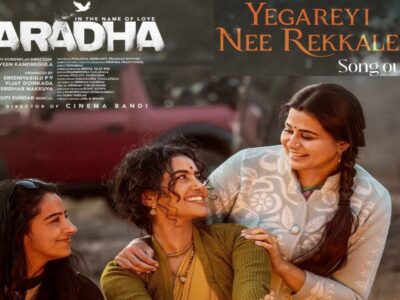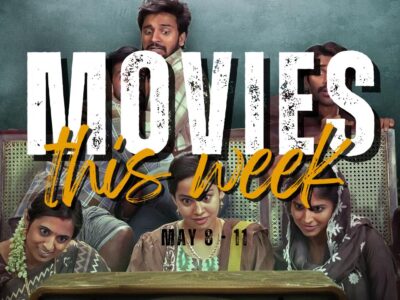Paradha Review : Anupama Parameswaran Shines in Praveen Kandregula’s Feminist Drama. A purposeful drama watchable despite the Misses…writes Rajeshwari Kalyanam
From Steve McCurry’s Afghan Girl to Paradha
American photojournalist Steve McCurry, today an award-winning celebrated photographer, had once (back in 1984) clicked a picture of an Afghan girl. The picture became extremely famous and made it to the cover of National Geographic. He won awards, and the picture went on to gain immense popularity—but no one knew who she was. It was only later she was identified, and she said in an interview that she wasn’t so thrilled. In fact, she revealed that she was angry that he clicked her picture. One is reminded of this history while watching Paradha – which attempts a social commentary.
Praveen Kandregula, who earlier made films like Subham and Cinema Bandi, made Paradha—which means “veil”—set in a village called Padathi, which means “a woman.” That sets the context for this film, which follows the director’s inimitable style of filmmaking we saw in his earlier films.
The Story of Paradha – A Village Bound by Tradition
Subbalakshmi’s World Behind the Veil
The village Padathi believes in a legend that women there must live in paradha. If by any chance a woman is seen by a man other than her own family without a veil, she is made to sacrifice her life. Otherwise, they fear that unborn babies of pregnant women will be harmed.
Subbalakshmi (Anupama Parameswaran) goes to college, is fun-loving, God-fearing, respectful towards elders, and caring—all this while wearing the veil, which her father makes and sells. Subbu is about to be engaged to the man she has loved since childhood (Rag Mayur), even before she started wearing the paradha. She is excited for her future.

When a Photograph Changes Everything
Then something unexpected happens: a photo of hers mysteriously appears on a popular magazine cover. A situation arises where she faces death as villagers fear Goddess Jwala whom they believe in will curse them, and she is forced to go in search of the photographer to prove her innocence.
The rest of the film is about this search, which leads to Subbu discovering herself in the process.
Performances – Anupama and Darshana Steal the Show
Anupama Parameswaran as Subbalakshmi
Director Praveen handles the subject intelligently, creating an engaging screenplay that touches upon patriarchy, discrimination, and prejudices women face. Anupama’s look and costumes are a plus, as she portrays the role of an intelligent and brave yet innocent girl to perfection. Rag Mayur shines in his role as a man bound by tradition and conditioning – despite his limited scope.
Darshana Rajendran’s Bold Portrayal of Amista
Subbu is accompanied by her mother’s friend (a part perfectly portrayed by Sangeetha). Along the way, they are joined by Darshana Rajendran as Amista, a civil engineer trying to make it in a man’s world. She is everything that Subbu isn’t—an epitome of modern thinking, an atheist who knows she has to work twice as hard as men to get ahead.
Yet, she faces setbacks when a less deserving man gets the position she deserves. For her, travelling with Subbu becomes an escape. Darshana’s layered performance adds strength to the narrative.
Supporting Cast and Notable Performances
Sangeetha shines in her role, while the ensemble cast contributes to the film’s emotional weight.
Direction & Screenplay – Praveen Kandregula’s Signature Style
Strong First Half with Suspense and Thrill
Praveen builds the story well in the beginning with suspense, thrill, emotions, and comedy, assisted ably by the cinematographer, editor, and music director Gopi Sundar.
Flat Narrative After Interval – Missed Opportunities
And then comes the interval, and Praveen ends up doing what he often does—simplifying his screenplay into an almost flat narrative, with no highs and absolutely no regard for climax or pre-climax. His major solution to the central conflict comes too soon, leaving the audience wondering what next. Characters literally spell out what he wishes to say at the cost of making it rhetorical.

Symbolism of the Veil as a Metaphor
The veil here is more than a physical entity—it becomes a metaphor for the many veils society forces upon women, confining their choices and freedoms.
Technical Aspects – Music, Cinematography & Visual Appeal
Gopi Sundar’s Music & Background Score
The score supports the film’s emotions well, though it doesn’t elevate the weaker second half. The overuse of “Yathra Naryanstu Pujyante” beats the purpose of the movie.
Visual Storytelling and Costumes
It was delightful to watch Darshana and Anupama in one frame. The visuals delivered by cinematography by Mridul Sujit Sen are stunning, and the costumes elevate the authenticity of the characters. Editing by Dharmendra Kakarala was on point and enhancing the movie.
Paradha Review – Verdict Balances Message and Misses
Paradha starts well and, despite being an important film that says all the right things, falters in cinematic rendition.
If audiences overlook this, it’s good news for the cast and technical team, who put up a brilliant show. Overall, Paradha is a good effort that one hopes will succeed despite its flaws—if only for its genuine intent.
Rating: 2.5/5















